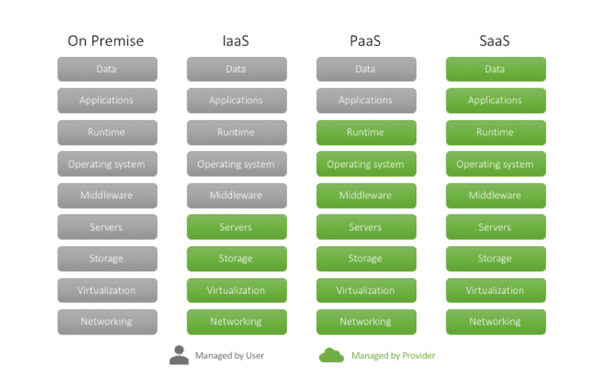Companies are changing the way they operate by leveraging internet and cloud services. Conventionally, businesses stored hardware, software and data on their own computers and databases. With cloud computing, they have access to their programs and data outside of their computing environment. They can use a cloud computing service on demand via the Internet. Rather than buying powerful computers and large databases, businesses can rent capacity from a cloud service provider and only pay for the resources they use. This might involve renting compute power, storage, software or other cloud services.
Types of Cloud Computing
Three deployment types of cloud computing offer different access and security options: Public, Private and Hybrid Cloud.
1. Public Cloud
Public clouds are owned and managed by cloud service providers (such as Microsoft, Amazon Web Services and Google) and stored off-site. Users have access to the cloud services via the Internet. Usually the public cloud offers more flexibility and cost saving.
2. Private Cloud
A private cloud refers to cloud services maintained on a private network and used exclusively by one organization. A private cloud is either located on a company’s on-site datacenter or hosted by a cloud service provider. A private cloud helps to reduce potential security and control risks. The term “community cloud” is sometimes used to refer to a private cloud that is shared with several organizations.
3. Hybrid Cloud
Hybrid clouds refer to public and private clouds combined which allow users to gain the benefits of both services. By connecting the workloads of a private cloud with a public cloud, a user can optimize the existing infrastructure and security. Hybrid clouds are valuable to companies with dynamic workloads. For example, retailers experience a spike in transactional orders during the holiday season. The retailer can run the system in a private cloud but use the public cloud to deal with the additional workload when demand spikes.
Types of cloud services
Today, the cloud comes in three flavors which form the cloud stack: Infrastructure as a Service (IaaS), Platform as a Service (PaaS), and Software as a Service (SaaS). SaaS is often built on a PaaS, which is built using IaaS.
1. Infrastructure as a Service (IaaS)
IaaS is the most basic type of cloud computing service giving users the most control over their IT architecture. Users can rent infrastructure from a cloud service provider; the services include servers, storage, networking hardware and virtualization.
2. Platform as a Service (PaaS)
PaaS is a cloud environment or platform for developers to build cloud applications. Providers of PaaS deliver an optimized environment (infrastructure and platform), database, an operating system, programming language execution capabilities as well as web servers where users can install applications and data sets. This enables users to focus on developing and managing software applications without installing on-site hardware and software. Like IaaS, the end user of the cloud application never interacts with the PaaS infrastructure. Microsoft Azure, Google Compute Engine, and Amazon AWS all have PaaS capabilities. Salesforce’s Force.com platform is another example of PaaS. The Salesforce apps available in the App Exchange are built on Salesforce’s Force.com platform.
3. Software as a Service (SaaS)
SaaS is what most people think of when they hear the name of a familiar cloud service they interact with via a client such as a mobile app or browser. It is also the most flexible model of cloud service and far more scalable. By using SaaS, users can connect to applications which are hosted by a cloud service provider. This makes it easier for users as the provider manages the application, maintenance (upgrades and security) and infrastructure. Users can choose to keep data in the cloud or locally, and applications in the cloud can be integrated with other software using application programming interfaces (APIs). Applications such as email, customer relationship management and human resource management commonly use SaaS.
Based on the above chart, companies can choose the type of cloud computing and cloud service depending on their access needs, security requirements and dependency level.
In the next post, we will dive in deeper to see why companies use cloud computing services.
Minju Kang is an Associate Product Manager (APM) at Loblaw Digital, Canada’s largest retailer. She was formerly an Associate Product Marketing Manager (APMM) at Microsoft within Azure. She also has experience in scaling product user cases at TD Bank and Overbond (fintech).
Image: San Storage, Pexels
Stay ahead in consulting & finance

